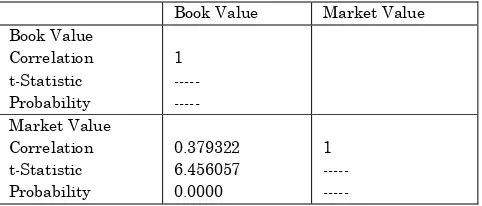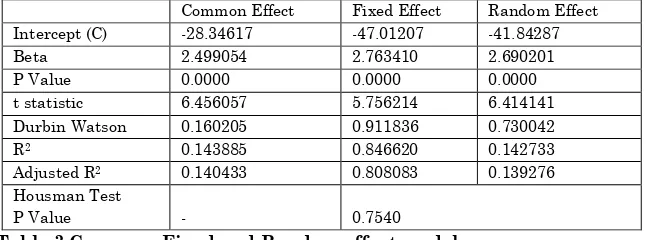ISSN 2286-4822 www.euacademic.org
Impact Factor: 3.1 (UIF) DRJI Value: 5.9 (B+)
Impact of Book Value on Market Value of Equity
Shares of Non Financial Companies in Pakistan
SYED MUHAMMAD JUNAID HASSAN Department of Management Sciences Balochistan University of Information Technology, Engineering and Management Sciences (BUITEMS) Quetta, Pakistan SYED NISAR AHMED Department of Management Sciences Balochistan University of Information Technology, Engineering and Management Sciences (BUITEMS) Quetta, Pakistan
Abstract:
The purpose of the paper is to study the relationship between book value and market value in Pakistani stock market. For this purpose the data of 50 companies listed in Karachi stock exchange for the period of 5 years i.e. from year 2007 to 2011 was collected from SBP Analysis. The data used was panel data so technique of panel data regression was used. Results indicate that there is a significant relationship between book value and market value.
Key words: Book Value, Market Value and Panel Regression
Introduction
capitalization and this will result in higher dividends and hence will attract more and more investors. Book value and market value are of pivotal importance to the company in financial perspective.
Book value and market value are two important indicators of how a firm is performing and to find out if there exists a significant relationship between the two variables this study was conducted. A similar type of study was conducted in India (Bhatt and Sumangala 2013, 109), but no study was found from Pakistan’s perspective, so an effort was made to fill this gap in literature, though the study is replication but there is uniqueness in it because of differences in the data. A different technique and arrangement of data is used which was lacking in the previous studies. Some contribution to the existing body of knowledge was intended. This effort might result in fruitful information that can be used for policy making.
The book value affects the market value and this in turn affects the position of the company in the market. Thus it can predict the movement of investors i.e. whether they will sell the shares of a particular company or buy them. The study is an important one in regard of being a very distinct study in the context of Pakistan. The paper is structured as follows: the literature regarding the very title of the paper, the technique that has been applied to gauge the relationship is discussed, then the study discusses the results and discussion tab and concludes with limitation and future research and the conclusion.
Literature Review
To create a better understanding the related terms and the variables used in this research are defined.
public and use that money for the business. There are two modes of financing, the company may choose to borrow money and in return it has to pay interest to the lender and the amount borrowed at maturity period or the company may offer ownership of company in exchange of cash invested by shareholders in the company - in return the company has to pay dividends to the shareholders and the money invested in case the company is liquidated or ownership of the company is transferred (shares are sold). The shareholder may not get all the money back that was invested or he may get more that the invested amount; it all depends on the mps and financial condition of the company. (Khan Academy 2011)
Equity shares: People are offering money; in return the company is offering ownership of the company, so the person who is purchasing shares of the company becomes owner of the company. (Khan Academy 2011)
There are two types of shares, namely preferred stock (preference shares) and common stock (ordinary shares). But ordinary shares are of interest to us as in Pakistani stock market most companies have issued common stock, with only few having issued preferred stock.
In the past studies people have used different variables to study their effect on other variables and sometime more than one variable are used to account for one variable. Only some of the past researches are discussed to build the background, being impossible to take into account all the work done.
Collins, Pincus and Xie (1999, 21) discussed what role the book value of equity plays in the valuation of equity.
Burgstahler and Dichev (1997, 187) measured the value of firm’s resources irrespective of how they are used in terms of earnings and book value.
Negative relation is eliminated if book value of equity is included in specification for the process of valuation. (Collins, Pincus and Xie 1999, 21)
Stewart (1997), Kaplan & Atkinson (1998), Fincham & Roslender (2003) Kanodia, Sapra and Venugopalan (2004, 89) have worked on the relationship between market value and book value of equities and have found that there is a difference between them and they have also tried to account for this difference. Fincham & Roslender (2003) argued that the difference in book value and market value of equity is due to the intangible assets.
Singhania (2006) has studied the relationship of different variables such as earning per share, book value, growth rate and dividend per share with market value of equity. Sharma (2011, 51) also conducted a similar study to see the effect of different variables on the market value of equity.
Bhatt and Sumangala (2013, 109) found that the variation in market value of equity can be explained on the basis of explanatory power of earning per share (EPS).
A study was conducted to assess the impact of book value of equity shares on the market value of equity shares in Indian stock market Bhatt and Sumangala (2013, 109). In this article an effort has been made to replicate the study using data from Pakistani stock market.
Methodology
Data used is already prepared by State Bank of Pakistan in financial statements analysis of companies (non-financial) listed at Karachi stock exchange (State Bank of Pakistan, 2011). The desired data was extracted from the report. In the case data was not available it could be extracted from company’s financial statements.
Book value of Equity Shares: The formula to find the book value of one equity share is given below:
Book Value of equity shares means the value of one share in the company, what amount of money will be paid to a person once the company is liquidated and all its debts are paid. (Khan Academy 2011) (Spaulding) The Book value of equity per share is multiplied with the number of outstanding shares to get Book value of all Equity Shares of a company.
Market value of Equity shares: Market value of one equity share is simply current market price of the equity share. But if there is a need calculate the market value of all equity shares of a company then the market price per share is multiplied with the number of outstanding shares.
Market value of equity shares is also known as market capitalization.
Once data is collected, first of all correlations are checked for the two variables. Then the suitable model is determined for regression on the basis of p value, t statistics and Durbin Watson stats.
effect model, the fixed effect model was also applied. The results of fixed effect model were significant and more appealing on basis of Durbin Watson stats. Random effect model has to be considered as well; to make a distinction between both fixed and random effect models, the Hausman test was applied. The results of the Hausman test were not significant, so finally it was concluded that fixed effect model should be used.
Results & Discussion:
Mean, median and standard deviation of book value and market value is given in the table 1.
Book Value Market Value
Mean 70.60900 148.1096
Median 38.75500 44.14000
Standard Deviation 76.26179 502.4295
Table 1 Mean, Median and Standard Deviation
On the basis of the correlation coefficient (0.379322), t statistic (6.456057) and probability (0.0000) (table 2), it can be stated that there is significant co-movement between book value and market value.
Book Value Market Value Book Value
Correlation t-Statistic Probability
1 --- --- Market Value
Correlation t-Statistic Probability
0.379322 6.456057 0.0000
1 --- ---
Table 2 Correlation Matrix
effect models.
The beta value of fixed effect tells us that if there is a 1 unit change in book value (independent variable) it will cause 2.76 units change in the market value of shares.
Common Effect Fixed Effect Random Effect Intercept (C) -28.34617 -47.01207 -41.84287
Beta 2.499054 2.763410 2.690201
P Value 0.0000 0.0000 0.0000
t statistic 6.456057 5.756214 6.414141
Durbin Watson 0.160205 0.911836 0.730042
R2 0.143885 0.846620 0.142733
Adjusted R2 0.140433 0.808083 0.139276
Housman Test
P Value - 0.7540
Table 3 Common, Fixed and Random effect models
Results show that the relationship between book value and market value is significant as the p value is less than 0.05; t statistic is greater than 2 and R2 (coefficient of determination) value shows that 84.6 % of variation in market value is explained on the basis of book value. The rest is due to alpha and error term; of course, besides book value, there are other participants also that can explain the variation/fluctuation in market value.
Conclusion:
it is concluded that book value has a significant effect on the market value of equity shares in Pakistan.
Limitations and Future work:
Limitations:
- Time constraint: Due to lack of availability of time, data was limited to 5 years.
- Availability of data: Consecutive data of only 5 years was available; there were gaps in the data otherwise.
- Fewer stock markets in Pakistan: there are only 3 stock exchanges in Pakistan.
Future work:
- To establish a generalization, data of more than 50 companies should be used and for 10 to 20 years’ time period or frequency of data may be increased by taking monthly, weekly or daily data.
- Data from more than one stock market from different countries may be used to establish international generalization.
BIBLIOGRAPHY:
Bhatt, Pushpa, and Sumangala, J. K. 2013. “Impact of book value on market value of an equity share – an empirical study in Indian capital market.” Gra - Global Research Analysis. 2(2): 109-111. Accessed January 14, 2014. http://theglobaljournals.com/gra/file.php?val=NTI0
Bild, Magnus. 1998. Valuation of takeovers. Master's thesis. Stockholm School of Economics.
607
Collins, Daniel W., Pincus, Morton, and Xie, Hong. 1999. “Equity valuation and negative earnings: The role of book value of equity.” The Accounting Review 74(1):
29-61. Accessed January 14, 2014.
http://www.jstor.org/discover/10.2307/248604?uid=37388 32&uid=2129&uid=2&uid=70&uid=4&sid=21103217981 607
Fincham, Robin and Roslender, Robin. 2003. The management of intellectual capital and its implications for business reporting. Master's thesis. University of Stirling.
Kanodia, Chandra, Sapra, Haresh, and Venugopalan, Raghu. 2004. “Should intangibles be measured: What are the economic trade-offs?” Journal of Accounting Research 42 (1): 89-120. Accessed January 14, 2014. http://www.researchgate.net/publication/4770965_Shoul d_Intangibles_Be_Measured_What_Are_the_Economic_ Trade-Offs/file/60b7d519fc23b2ba0b.pdf
Kaplan, Robert S. and Atkinson, Anthony A. 1998. Advanced management accounting. Upper Saddle River: Prentice Hall.
McDonald’s Corporation. 2008. “McDonald’s Happy Meal Toy Safety Facts.” Accessed July 19. http://www.mcdonalds.com/corp/about/factsheets.html. Khan Academy. 2011. “What it means to buy a company's
stock.” Accessed January 14.
https://www.khanacademy.org/economics-finance- domain/core-finance/stock-and-bonds/stocks-intro-tutorial/v/what-it-means-to-buy-a-company-s-stock Khan Academy. 2011. “Equity vs. debt.” Accessed January 14.
https://www.khanacademy.org/economics-finance- domain/core-finance/stock-and-bonds/venture-capital-and-capital-markets/v/equity-vs--debt
https://www.khanacademy.org/economics-finance- domain/core-finance/stock-and-bonds/stocks-intro-tutorial/v/bonds-vs--stocks
Sharma, Sanjeet. 2011. “Determinants of equity share prices in India.” International Refereed Research Journal 2(4):
51-60. Accessed January 14, 2014.
http://www.researchersworld.com/vol2/issue4/Paper_6.p df.
Singhania, Monica. 2006. “Determinants of equity prices in the stock markets.” The IUP Journal of Applied Finance.
Accessed January 14, 2014.
http://www.iupindia.in/906/IJAF_Determinants_of_Equi ty_Prices_39.html
Spaulding, William. C. (n.d.). “Equity valuation: Book value, liquidation value, and Tobin’s q ratio.” Accessed January 14. http://thismatter.com/money/stocks/valuation/book-liquidation-value-q-ratio.htm
Stewart, Thomas A. 1997. Intellectual capital: the new wealth of organizations. London: Nicholas Brealey.

